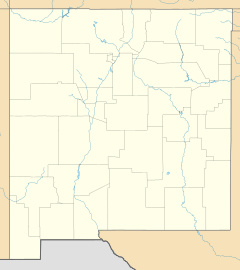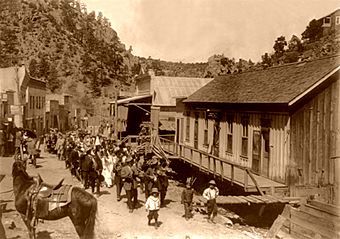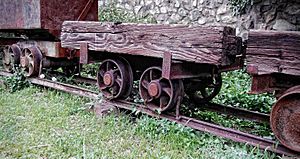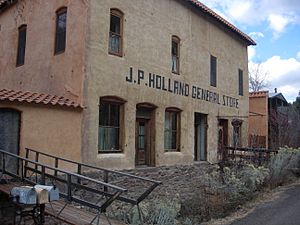Mogollon, New Mexico facts for kids
Quick facts for kids
Mogollon, New Mexico
|
|
|---|---|
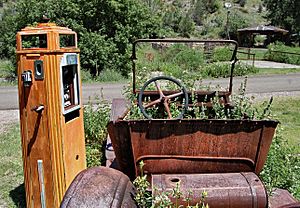
Street scene in the Mogollon Historic District
|
|
| Country | United States |
| State | New Mexico |
| County | Catron |
| Population
(2000)
|
|
| • Total | 0 |
| Time zone | UTC-5 (Mountain (MST)) |
| • Summer (DST) | MDT |
| Area code(s) | 575 |
Mogollon, also known as the Mogollon Historic District, is a former mining town. It is located in the Mogollon Mountains in Catron County, New Mexico, United States. The town was founded in the 1880s. It was built to support the gold and silver mines in the nearby mountains.
The "Little Fannie" mine was the most important employer in Mogollon. In the 1890s, between 3,000 and 6,000 miners lived there. Mogollon was known as one of the wildest mining towns in the West. This was because it was very isolated. Today, Mogollon is listed as the Fannie Hill Mill and Company Town Historic District on the National Register of Historic Places.
Contents
History of Mogollon
In the 1870s, a soldier named Sergeant James C. Cooney found a lot of gold. He found it in the Gila Mountains, near where Mogollon would later be built.
Town's Beginnings
A miner named John Eberle built the first cabin in Mogollon in 1889. This happened after mines started in Silver Creek. A jail and a post office opened in 1890. The first school was built in 1892.
As Mogollon grew, it took in people from nearby Cooney. It also helped towns like Glenwood, Gila, and Cliff grow. These towns were along the main trail to Mogollon. Between 1872 and 1873, the stagecoach from Mogollon to Silver City was robbed 23 times. The same person did all the robberies. Agents from Wells Fargo eventually caught him.
Life in the Mines
The Little Fanny mine was very dusty. Miners often got sick from breathing the dust. This sickness was called "miner's consumption." It caused miners to work at Little Fanny for only three years or less. To help with this, the mine owners found a solution. They started spraying water under pressure from the jackhammers. This helped reduce the dust in the air.
By 1909, about 2,000 people lived in Mogollon. The town had a photographer, a theater, an ice maker, and a bakery. The Silver City and Mogollon Stage Line offered daily service. They carried people, goods, gold, and silver. The trip between the two towns was eighty miles and took almost fifteen hours.
Growth and Modernization
By 1915, the monthly payroll in Mogollon was $75,000. The town's population grew to 1,500 people that year. Mogollon also got electricity, water, and telephone services. The school taught about 300 students.
Challenges and Disasters
Mogollon faced many fires and floods. The first big fire in 1894 destroyed most of the wooden buildings. More fires happened in 1904, 1910, 1915, and 1942. After each fire, people quickly rebuilt. They started using more stone and adobe to make buildings stronger.
Floods also hit Silver Creek in 1894, 1896, 1899, and 1914. These floods washed away mine waste, bridges, houses, and even people.
Decline and Modern Day
During World War I, the demand for gold and silver went down. Many of Mogollon's mines closed. By 1930, the population had dropped to about 200 people. The town grew a little again in the late 1930s when gold prices rose. However, during World War II, it shrank again and never fully recovered.
In 1973, a movie called My Name is Nobody was filmed in Mogollon. It starred Henry Fonda and Terence Hill. A saloon and a general store were built in town for the movie set.
Today, the town is privately owned. It has a few small businesses. One is the Silver Creek Inn, which used to be a boarding lodge called the Mogollon House. It was built in 1885. Some people say the inn is filled with ghosts from the mining days!
Mogollon Historic District
The entire Mogollon community is listed on the National Register of Historic Places. It was added in 1987 as the Fannie Hill Mill and Company Town Historic District. This recognizes its important history in industry and architecture from 1875 to 1949.
Education
Mogollon is part of the Reserve Independent School District.
See also
 In Spanish: Mogollón (Nuevo México) para niños
In Spanish: Mogollón (Nuevo México) para niños


